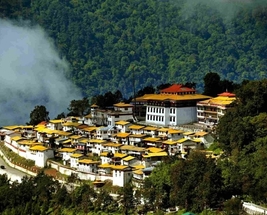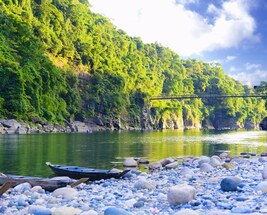The state of Meghalaya is in the northeastern region of India, and it shares its borders with Bangladesh and Assam. The Sanskrit meaning of the state’s name translates to “Abode of Cloud”, which it gets from the enormous amount of annual rainfall that occurs in the region. Meghalaya’s unparalleled natural beauty makes it a highly sought-after holiday destination in India. However, the major tourist attractions in Meghalaya go far beyond its national parks, natural landforms, waterfalls, towering peaks, caves, and so on. The region has been a prominent centre of history and culture in the country since ancient times. Meghalaya has been inhabited since the Neolithic period, making it a prime spot of interest for archaeological activities. It was also a subject of the British colonial rule of India, where they replaced the local tribal kingdoms of Jaintia, Khasi and Garo with their own administration. The British called Meghalaya the “Scotland of the East” due to their identical landscapes.
Thus Meghalaya’s rich past covers a vital sector of India’s history, which draws many casual tourists and history buffs to the region. With such a rich past, it is only natural for the state to house several historical monuments dating back to the forgone era. From historical buildings and archaeological sites to statues and stone memorials, there are a lot of things to uncover on a Meghalaya trip. Some major monuments in Meghalaya include David Scott Memorial Stone, Nartiang Monoliths, Kiang Nongbah Monument, Manipur Memorial, etc.
Monuments in Meghalaya
From incredible stone memorials in honour of the erstwhile rulers of the region to archaeological sites uncovering the earliest signs of human civilisation, history is embedded in every part of Meghalaya. Besides being popular tourist attractions, these marvellous sites also help individuals learn more about the region’s local culture and vast history. Here are some of the most well-known Meghalaya monuments that you can check out:
Nartiang Monoliths:
The Nartiang Monoliths in Jaintia Hills are one of the largest collections of Megalithic stones found within a single area. The site helps to preserve a crucial fragment of the region’s royal history and enables visitors to learn more about it. This garden of monoliths features several upright stones (Menhirs) and horizontal stones (Dolmens). These monoliths were erected as monuments of the previous rulers of the region and also to mark their achievements. Among this massive collection, the tallest monolith is locally known as Moo Long Syiem. It is about 26 feet tall and was erected by U Mar Phalyngki to commemorate a military victory. The rest were erected by several clans of the Nartiang Village between the period of 1500 to 1835 A.D.
- Location: North of Nartiang Market, Nartiang, West Jaintia Hills
- Prices Charged: There is no entry fee charged to visit the Nartiang Monoliths.
- Best time/season to visit: You can check out the site at any time of the year. However, consider visiting during the early morning or afternoon for the ideal view and the serene atmosphere.
David Scott Monument:
The David Scott Monument in Cherrapunji is one of the most important and famous historical monuments of Meghalaya. It commemorates a British official named David Scott who was employed by the East India Company during the colonial era. He was widely known as a sincere and dedicated worker, and his demise on 20th August 1831 left a huge impact on the Governor-General’s office. Hence, an obelisk-shaped monument made of ashlar stone was erected in his honour. The tribute written on the memorial pillar by the British Raj is also a noteworthy aspect of the site. A path leading to the monument, called “David Scott Memorial Trail,” has become quite famous among tourists for hiking.
- Location: Cherrapunji, East Khasi Hills
- Prices Charged: No entry fee is required.
- Best time/season to visit: The best time to visit the monument and walk the trail is between October to February.
Megalithic Bridge on Um-Nyankanah River:
One of Meghalaya’s most common tourist attractions is its numerous megalithic bridges spread across the region. The Megalithic Bridge on the Um-Nyankanah River is a popular site that attracts thousands of visitors throughout the year. It is a bridge made of massive stone slabs resting upon four giant stone pillars. It is believed that this monolithic bridge was built under the reign of the Jaintia Kings of Jaintiapur in the mediaeval era. Its primary purpose was to promote trade, communication and transport between the ruling regions. The bridge is now a prime attraction for casual tourists and history buffs and is protected under the Archaeological Survey of India (ASI).
- Location: Between Jowai and Jarain in the Jaintia Hills district
- Prices Charged: No entry fee is required.
- Best time/season to visit: You can visit the Megalithic Bridge on the Um-Nyankanah River at any time of the year, preferably in the early morning.
Megalithic Bridge called “Thul-Um-Wi”:
Locally called Thul-Um-Wi, it is another remarkable megalithic bridge found in the district of Jaintia Hills. It resembles a similar structural composition, featuring large stone slabs and support pillars. Local legends indicate that it was also built under the reign of the Jaintia rulers with the purpose of maintaining trade and commerce with other ruling regions. This simple yet beautiful bridge is an important historical monument and one of the well-known Meghalaya tourist places. One of the stone slabs of this bridge broke down when an elephant tried to cross it several years after its construction. The broken section is still a part of the structure and makes for a beautiful backdrop for photographs.
- Location: Between Jowai and Jarain, Jaintia Hills
- Prices Charged: No entry fee is required
- Best time/season to visit: The best time to visit this mediaeval bridge is in the early morning, during any month.
Megalithic Bridge on Um-Kumbeh:
This stone bridge is one of the most beautiful historical monuments of Meghalaya. It was built by laying massive stone slabs over the Um-Kumbeh River, supported by giant stone pillars at the bottom. According to local legends, this stone bridge was built by U Luh Lyngskor and Mar Phalangki under the orders of the then-Jaintia King. It is also believed that the bridge’s construction took place following the shift of the capital from Sutnga to Nartiang. This megalithic bridge assisted in maintaining trade and communication between the Jaintia Kingdom’s old and new capitals. The stones used to make the bridge date back to the 18th century AD.
- Location: Near Syndai, district of Jaintia Hills
- Prices Charged: There is no entry fee.
- Best time/season to visit: This bridge is perfect for a quick visit at any time of the year.
Manipur Memorial:
The Manipur Memorial is one of the most significant historical monuments in Meghalaya. Located just 2.2 kilometres from Shillong’s city centre, it is a massive tourist attraction in the region. The memorial is a tall, octagonal-shaped structure made of ashlar stone, standing on a gradually receding platform. It was erected to commemorate Mr Quinton and several other British Military officials who lost their lives in Manipur in the year 1891. There are also inscriptions engraved into the memorial that briefly describe the cause of their demise.
- Location: Shillong, East Khasi Hills District
- Prices Charged: NA
- Best time/season to visit: The Manipur Memorial in Shillong is a famous tourist attraction that you can visit at any time of the year. However, consider going early in the morning during the peak season to avoid crowds.
Stone Memorial of U-Maw Thodur-Briew:
Located in Nartiang, the Stone Memorial of U-Maw Thodur-Briew is one of the most popular Meghalaya monuments. The memorial is built by and dedicated to the people of U-Maw Thodur-Briew, a local tribe in the region. The megalithic stones in the memorial are generally classified into three categories, called Dolmens, Menhirs and Cairns. Menhirs are more common than the other two types, with the tallest being around 9 metres tall. These menhirs are raised in groups, ranging between three to seven at a time, with the middle one towering over others. A capstone, representing a hat or the shape of a head, is often provided over these menhirs.
- Location: Nartiang, Jaintia Hills District
- Prices Charged: NA
- Best time/season to visit: It is one of those tourist sites in Meghalaya that you can visit at any given point of the year and have the same experience while exploring.
Kiang Nongbah Monument:
The famous Kiang Nongbah Monument is one of the most iconic historical monuments of Meghalaya. Located on a massive field called “Madiah Kmai Blai” by the banks of the Myntdu River, the monument commemorates U Kiang Nongbah. He was a Jaintia patriot who fought for the freedom of his region during British colonial rule. He died as a martyr for his cause by public hanging on 30th December 1862. People from all over India as well as the world, visit the Kiang Nongbah Monument to pay their respects and learn more about the region’s historical heritage.
- Location: Jowai, Jaintia Hills District
- Prices Charged: NA
- Best time/season to visit: The monument is open to visitors any time of the day, so you can visit it whenever you are in the area.
Stone Memorial of U-Mawthoh-Dur:
Following their traditions and beliefs, the Khasi tribes erected several monoliths throughout the ages to honour their tribe and heroes. Such monoliths can be found within Meghalaya’s Bhoi Area, believed to have been constructed by the people of Khasi communities. This massive monolithic stone memorial is locally known as U-Mawthoh-Dur, and is among the most well-known historical landmarks in the region. Both casual tourists and history buffs like to visit this stone memorial in Meghalaya.
- Location: Bhoi Area, East Khasi Hills District
- Prices Charged: NA
- Best time/season to visit: It is better to visit the stone memorial during the day as it is more suitable for exploration.
Bhaitbari:
The earliest signs of civilization in Meghalaya date back to the Neolithic period. Hence it has been a major site of interest for archaeological activities. One of the most famous archaeological sites discovered in the state is Bhaitbari. Lying close to the Assam-Meghalaya border, the site was involved in a short excavation between 1991-92, which resulted in several crucial historical findings. The findings include the discovery of a 5 kilometres long burnt brick-mud fortification, a planned brick-built temple with 28 terracotta tiles, an Octagonal Temple with multiple Shiva Lingas, and a stupa (structure related to Buddhism). The ruins of this ancient kingdom date back to the 4th-8th century AD. These ancient monuments have piqued the interest of several history buffs and tourists in recent years.
- Location: In the point of Old Bhaitbari in the West Garo Hills district
- Prices Charged: NA
- Best time/season to visit: Visiting this archaeological site is not bound to a specific season. However, make sure to visit during the morning so you can explore everything properly.















